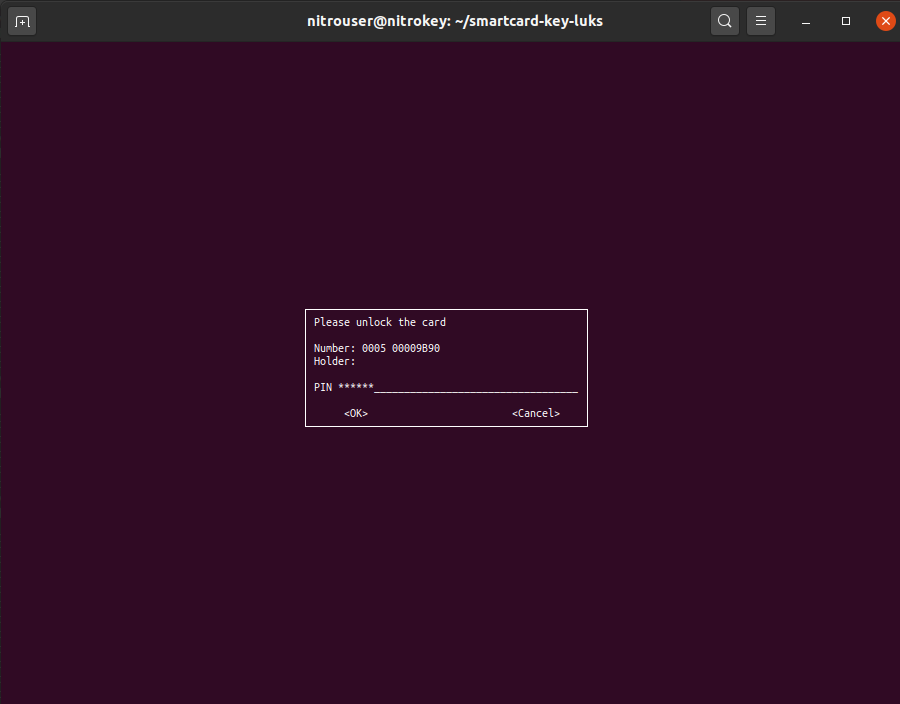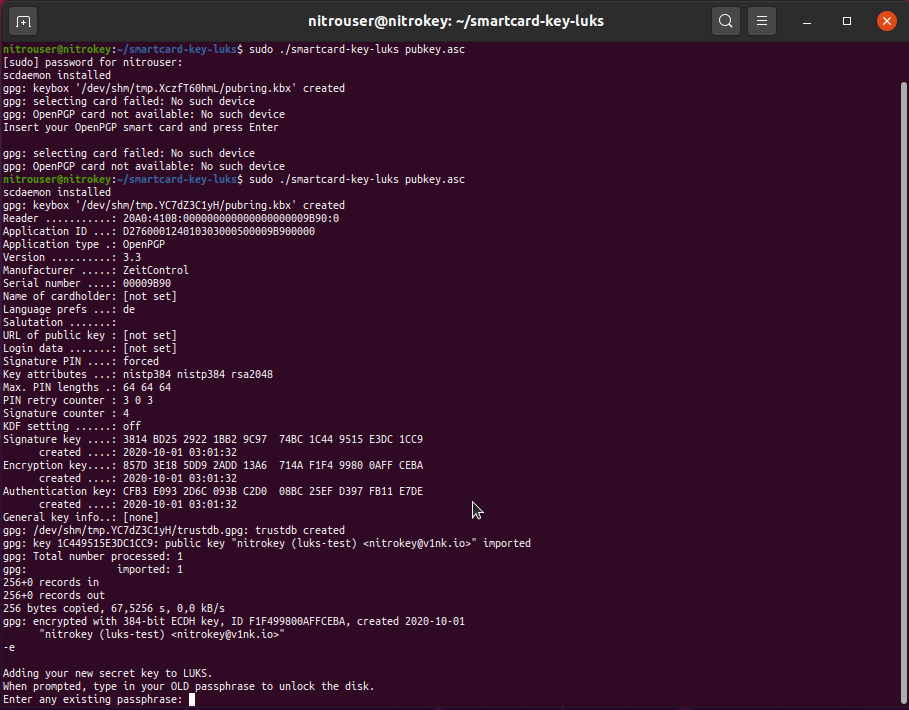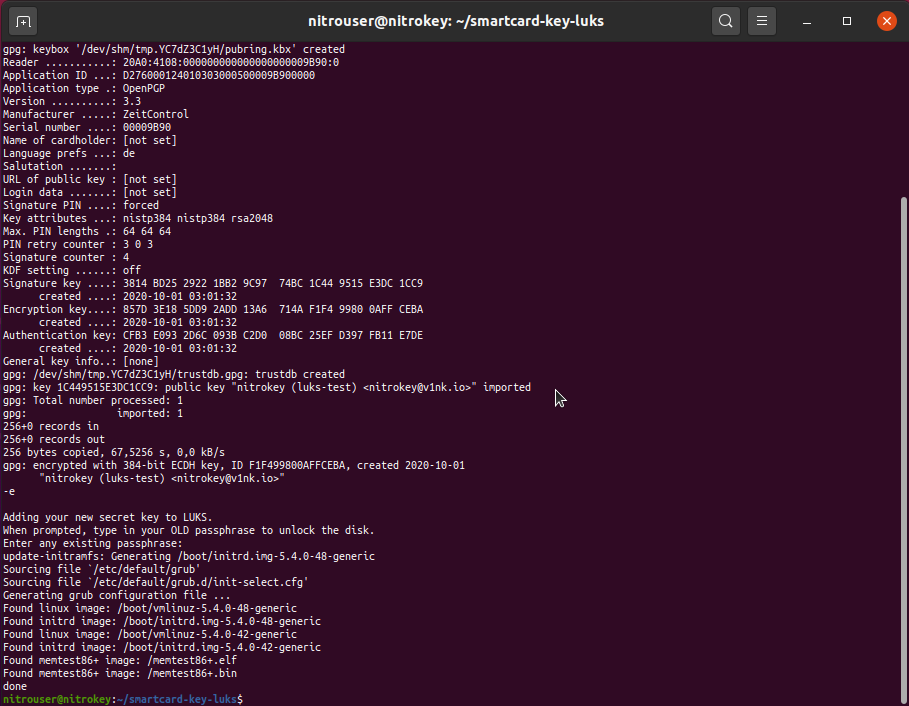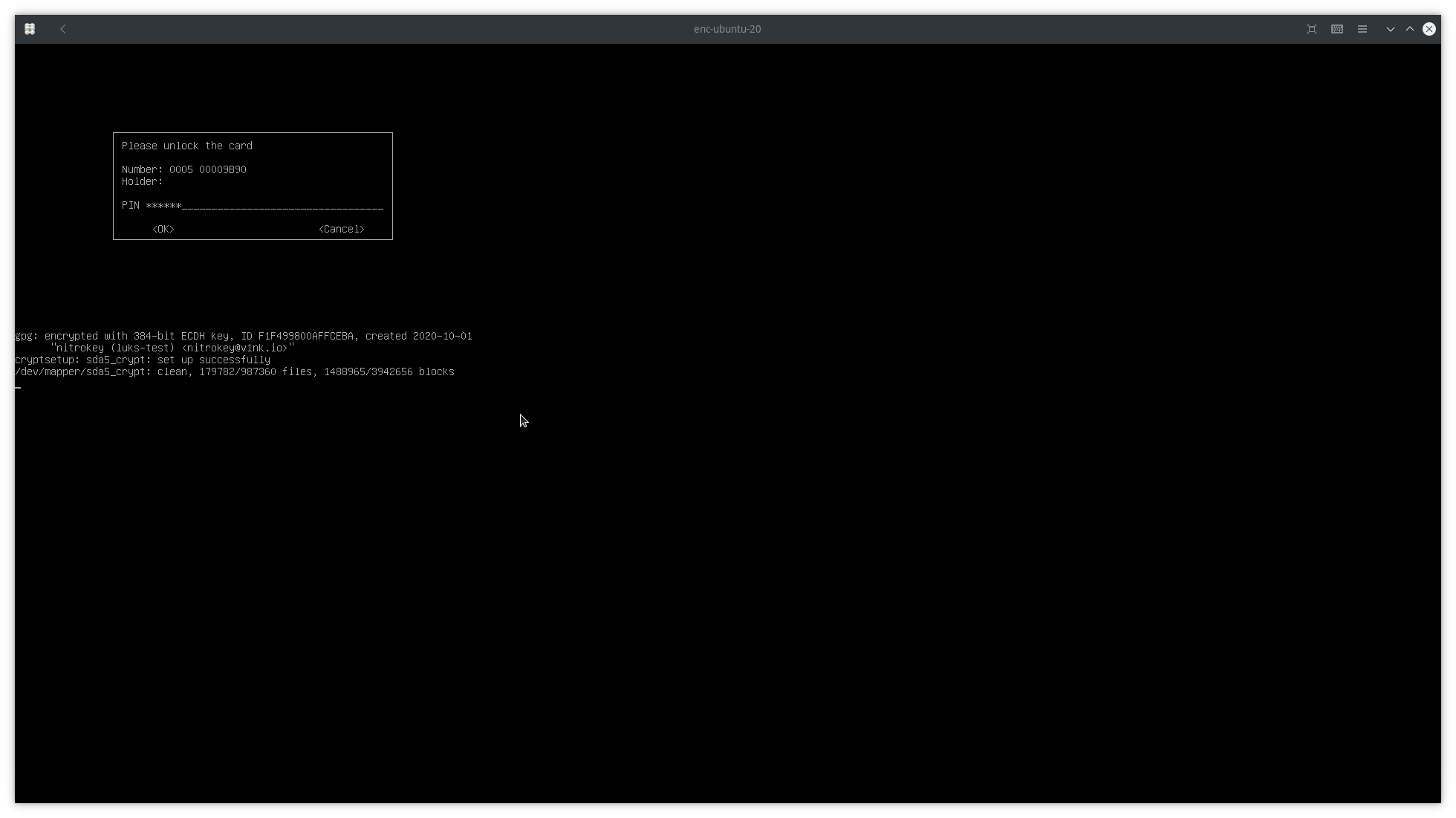Full-Disk Encryption With cryptsetup/LUKS¶
Compatible Nitrokeys |
|||||||
|---|---|---|---|---|---|---|---|
✓ active |
⨯ inactive |
⨯ inactive |
✓ active |
⨯ inactive |
✓ active |
✓ active |
⨯ inactive |
This guide shows how to configure LUKS-encrypted volumes, to authenticate at boot with Nitrokey Pro or Nitrokey Storage.
To provide some background, cryptsetup-initramfs now has support for using OpenPGP smart cards like the Nitrokey Pro and Nitrokey Storage to unlock LUKS-encrypted volumes. Once you finish the setup, you will just need to insert your Nitrokey at boot and enter your User PIN, instead of typing in your regular disk encryption passphrase.
These instructions have been tested on Ubuntu 20.04 and Debian 10.
Warning
The following guide can potentially lock you out of your computer. You should be aware of these risks, and we recommend you use the script below on a secondary computer, or after a full backup as you might lose your data.
Requirements¶
An Ubuntu or Debian computer with at least one LUKS-encrypted volume.
See the section below to determine which method is compatible with this guide.
A Nitrokey Pro 2 or Nitrokey Storage 2 initialized with keys.
Known Issues¶
So far, the script works only with manually-partitioned volumes, that are
composed of an unencrypted /boot partition, and an encrypted root /
partition.
Please do not select the automatic full-disk encryption provided by the operating system you are using for this guide. You will face recurrent errors when the partitioning is done automatically, using the installation interface on Ubuntu and Debian.
Instructions¶
Install dependencies
$ sudo apt install scdaemon opensc gnupg2
Create smartcard-luks directory
$ mkdir smartcard-luks && cd smartcard-luks
Download the smartcard-luks-script
$ wget https://raw.githubusercontent.com/daringer/smartcard-key-luks/main/smartcard-key-luks $ sudo chmod +x smartcard-key-luks
Export the public key
To export your public key from GnuPG’s keyring:
$ gpg2 --armor --export KeyID > pubkey.asc
If you already have uploaded a public key to a keyserver (or have it stored somewhere else), you should retrieve it in the way you are most comfortable with, and proceed to step 5.
Determine and verify the correct LUKS device name for your root-partition:
$ cat /etc/crypttab # if there is only one entry, you want the 1st column of this entry
Hint
Usually this should be something like nvme0n1p3_crypt (for NitroPC) or sda3_crypt (for NitroPads). You can and should crosscheck that the UUID referred inside /etc/crypttab is the designated partition by checking the symbolic link inside /dev/disks/by-uuid/.
Execute the script with the luks device name (e.g., nvme0n1p3_crypt) and pubkey.asc as arguments.
$ sudo ./smartcard-key-luks nvme0n1p3_crypt pubkey.asc
Once, you run the script with the OpenPGP public key as argument, it automatically sets up a new LUKS secret, encrypts it against that public key, and sets up crypttab, LUKS, initramfs, and GRUB.
First you will be prompted for the User PIN

Once you unlock the Nitrokey, you will be prompted for your OLD passphrase.
It is the passphrase you entered to encrypt your volume at installation.

Note
This is a fall-back alternative in case you lose your Nitrokey, or if it’s unavailable. So far, it was not tested, and users must be aware of the risk of getting locked out of their computer, if the fall-back method does not work.
Once you enter the passphrase, the script finishes the setup in about one minute. Do not interrupt the script, or you might get locked out of your computer after reboot.

Done!
By now you must reboot, and you should be able to use your Nitrokey to unlock your encrypted drive.
Usage¶
After reboot you should be prompted for your User PIN

Enter your User PIN to unlock the drive

Further Hints¶
Change Passphrase¶
Once this setup is done, you should not use the (gnome) disks utility anymore to change the (fallback) passphrase. The proper way to do this is to call cryptsetup directly like this:
$ sudo cryptsetup luksChangeKey /dev/nvme0n1p3
With nvme0n1p3 being the partition you set up the keys for.
Use Multiple Keys¶
It is easy to use multiple (hardware) security keys so that each of them is able to unlock the LUKS drive independently. Just export multiple public keys and also pass multiple keys to the setup script like this:
$ sudo ./smartcard-key-luks nvme0n1p3_crypt pubkey-1.asc pubkey-2.asc
Set Cardholder Name¶
During the PIN entry on boot for decryption of the LUKS root partition a cardholder is presented
to the user, to set this please use $ gpg --edit-card and inside the prompt type admin and
name to set the cardholder for the OpenPGP Card (Nitrokey Storage 2 or Nitrokey Pro 2).
Replace/Delete Keys¶
It is not possible to add/remove keys directly. Therefore you need to delete/remove the old setup and re-run the setup with the designated key(s):
Remove the keyfile (path, if you used the script above) from luks-device (nvme0n1p3):
$ sudo cryptsetup luksRemoveKey /dev/nvme0n1p3 /etc/cryptsetup-initramfs/cryptkey.gpg
Remove the keyfile itself:
$ sudo rm /etc/cryptsetup-initramfs/cryptkey.gpg
Re-run setup above.
Unlocking LUKS2 with X509 certificate¶
SystemD supports unlocking a LUKS2 partition using a X509 certificate, find a great blog entry on how to realize this at the Personal blog of Vladimir Timofeenko